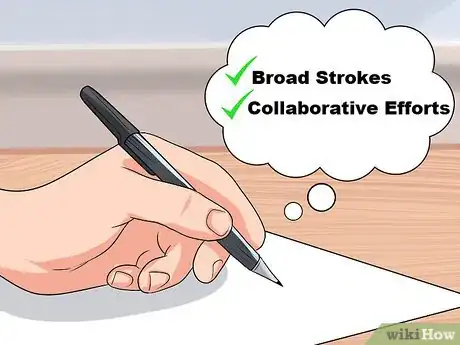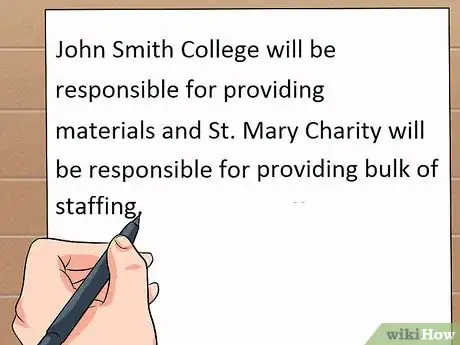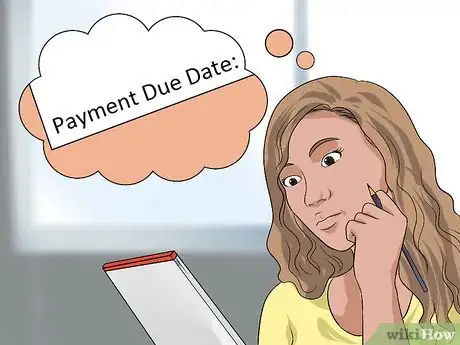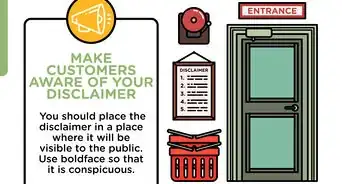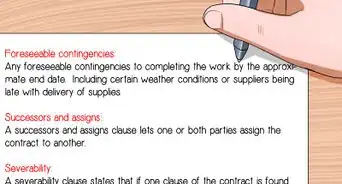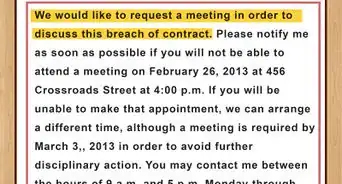This article was written by Jennifer Mueller, JD. Jennifer Mueller is an in-house legal expert at wikiHow. Jennifer reviews, fact-checks, and evaluates wikiHow's legal content to ensure thoroughness and accuracy. She received her JD from Indiana University Maurer School of Law in 2006.
wikiHow marks an article as reader-approved once it receives enough positive feedback. In this case, 94% of readers who voted found the article helpful, earning it our reader-approved status.
This article has been viewed 67,021 times.
A memorandum of agreement, or MOA, is a written document that describes and defines the cooperative relationship between two parties who want to work together to achieve common goals. MOAs are most common in the nonprofit and research sectors, particularly when a for-profit corporation wants to work with a nonprofit organization or research institution to produce advancements in a particular field. The agreement itself can be as simple or as elaborate as you want it to be, and in most cases the completed and signed document will not be legally binding. Rather, it serves as an outline to provide guidance for those working on the project.
Steps
Establishing the Agreement's Purpose
-
1Include a discussion of the problem to be addressed. Although it's not necessary, you may want to include a statement of the problem or issue that motivated the two parties to work together.
- If the partnership is intended to combat a problem, you may want to begin the agreement by discussing the impact of the issue and how it affects people.
- For example, if your organization is partnering with a company to research a cure for a disease, begin by describing the disease and the damage it does to people.
-
2Identify the parties involved. Begin your agreement by providing the names of the organizations or business entities that will be working together.
- Make sure you include general contact information for each party to the MOA, as well as names and contact information for leaders or key point people on the project.
- You also might want to note any other connections or affiliations each entity has, especially if those associations will be used to pursue an objective outlined in the MOA.
Advertisement -
3Explain why the parties came together. Your explanation here should focus less on the overall goals of the project and more on what each party brings to the table and why you can accomplish more by joining forces.
- Include any motivating factors, such as funding, experience, or resources, that make the partnership especially valuable.
- If one party initiated the partnership and chose the other from a field of applicants, you might want to include that information as well.
-
4Describe the scope of the work that will be done. Provide a basic description of what the project anticipated by the agreement will entail.
- This description should include the broad strokes of the collaborative efforts between the parties to the agreement.
- Reference the agreement and state that it spells out the particular terms of the partnership.
- Although the agreement may not be legally binding, you can note that the agreement will be used to define and guide the relationship and operations.
-
5Summarize the purpose of the agreement. Close the introduction of your agreement by explaining what the project hopes to achieve.
- You may want to start this paragraph of the agreement with language such as, "Through this agreement, [Organization A] and [Organization B] hope to ..." and then describe the purpose.
Detailing Roles and Responsibilities
-
1Describe collaborative tasks. Any specific aspects of the project in which both parties will be working in concert should be outlined first. Use as much detail as possible in describing the individual tasks.[1] Keep in mind that collaborations work best when both parties understand exactly what's expected of them.
- Include specifics such as dates, numbers of people working, and locations if any of these details are available or relevant to the task being completed.
- Being as specific as possible in the MOA can prevent misunderstandings and disagreements that can create animosity among staff and make it difficult to achieve your common goals.[2]
-
2Categorize the work to be performed. Depending on the size and scope of your project, the types of tasks to be done may fall under several categories. For example, if you are a nonprofit youth organization partnering with a state organization to create an after-school activity center, you might have tasks to be completed in technology, construction, design, education, and planning categories.
- You also might want to include categories for marketing, publicity, or recruitment efforts.
- Within each category, you can more easily specify in precise terms what each party will be responsible for completing.
- Organize your agreement the way it most makes sense to you and will be easiest to follow.
- In some situations, it may make sense to organize it by categories, while in others you may want to list each party's responsibilities separately.
-
3Specify the roles of each party. After you've placed the tasks into general categories, you should detail what each party is expected to contribute to the final goal. For example, one party may be responsible for providing materials while the other party provides the bulk of the staffing to complete the project.
- In the research sector, you may have university students doing the actual research while the company with which the MOA is being entered provides the samples for testing.
- If one party's completion of certain tasks is dependent or contingent on the other party's performance, you should note that in this section.
- In addition to specific roles, include other responsibilities or obligations created by the MOA, such as acknowledgement of the other party in publications or media coverage of the project.[3]
- You should also address the ability to use the other party's trademarked logos.[4]
-
4Clarify the goals of the project. You should identify multiple sub-goals or benchmarks as well as the ultimate goal of the work being performed under the agreement. If one party has supervisory authority, you may want to schedule regular audits, evaluations, or assessments of the work being completed. Otherwise, you should determine how best to ensure any stated benchmarks are being met.
- Your goals may depend on whether you are collaborating with the other party for a specific project, or sharing resources for a longer period of time.[5]
- You also may create an MOA because you and another party have agreed to share resources, such.[6] In these sorts of partnerships, your MOA should delineate which resources are shared and which remain separate.
- If services are being provided to the public, make sure the target population and numbers of people you intend to be equipped to help are clearly defined.[7]
Setting the Terms
-
1State the dates the agreement will be in effect. You may want your agreement to last for a specified period of time, or you may set it to continue until certain goals or benchmarks are reached.
- If you intend the agreement to take effect from the moment it is signed, include that language, and make sure dates are included next to the signatures of the parties.
- If you've decided the agreement will end once a certain goal is achieved or project is completed, make sure you've included adequate evaluation procedures.
- If your agreement has addressed the use of intellectual property such as trademarked logos, include a provision along with the dates of the MOA that addresses ownership of that IP.[8]
-
2Consider including a payment schedule. If one party is to provide funding for the project, you may want to include the payment schedule in your MOA or reference a separate contract that outlines those numbers.
- If one party is providing funding for the project, you may want to set periodic payments on specific dates, or after the verified completion of specific stages of the project.
- Keep in mind that since MOAs typically aren't viewed as legally binding, you may want to create a separate contract that makes the payments binding.[9]
- At the same time, if an MOA includes provisions regarding specific amounts of money, courts will almost always view the agreement as a legally binding contract.[10]
-
3Describe how the agreement can be modified or terminated. After work begins, the project may evolve or new issues may appear that weren't contemplated when you made the agreement.
- Since you have a written agreement, you want to provide that the agreement can only be modified or updated with another written agreement.
- Since the partnership and collaboration is voluntary, you probably want to allow either party to terminate the agreement at any time.
- Keep in mind that since MOAs aren’t legally binding, your MOA won't include many of the recitals related to damages and breach that typically are found in contracts.[11]
-
4Create signature blocks for each party's principals. The signature of people with the authority to bind their organizations will set the agreement in motion. Make sure you provide the MOA to the other party so representatives can review it before signing.
- If they disagree with anything in the MOA, or need clarification on any of the terms, you may need to rewrite the document to address those points.[12]
- Once both parties have signed, make at least one copy for each party, and keep the original in a safe and mutually accessible place.
References
- ↑ http://ctb.ku.edu/en/table-of-contents/structure/organizational-structure/understanding-writing-contracts-memoranda-agreement/main
- ↑ http://ctb.ku.edu/en/table-of-contents/structure/organizational-structure/understanding-writing-contracts-memoranda-agreement/main
- ↑ http://ctb.ku.edu/en/table-of-contents/structure/organizational-structure/understanding-writing-contracts-memoranda-agreement/main
- ↑ http://ctb.ku.edu/en/table-of-contents/structure/organizational-structure/understanding-writing-contracts-memoranda-agreement/main
- ↑ http://ctb.ku.edu/en/table-of-contents/structure/organizational-structure/understanding-writing-contracts-memoranda-agreement/main
- ↑ http://ctb.ku.edu/en/table-of-contents/structure/organizational-structure/understanding-writing-contracts-memoranda-agreement/main
- ↑ http://ctb.ku.edu/en/table-of-contents/structure/organizational-structure/understanding-writing-contracts-memoranda-agreement/main
- ↑ https://www.upcounsel.com/memorandum-of-agreement
- ↑ http://ctb.ku.edu/en/table-of-contents/structure/organizational-structure/understanding-writing-contracts-memoranda-agreement/main
- ↑ http://ctb.ku.edu/en/table-of-contents/structure/organizational-structure/understanding-writing-contracts-memoranda-agreement/main
- ↑ http://ctb.ku.edu/en/table-of-contents/structure/organizational-structure/understanding-writing-contracts-memoranda-agreement/main
- ↑ http://ctb.ku.edu/en/table-of-contents/structure/organizational-structure/understanding-writing-contracts-memoranda-agreement/main



